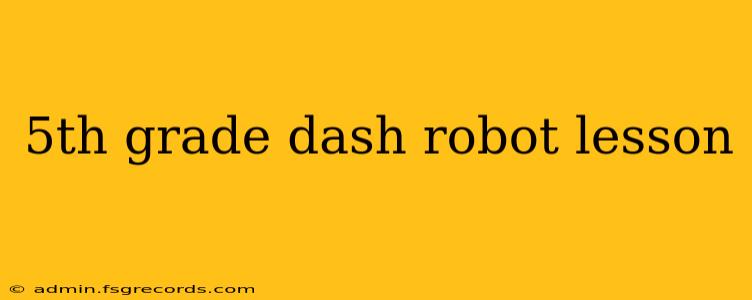This lesson plan provides a fun and engaging introduction to coding and robotics for 5th graders using the Dash robot. We'll cover fundamental coding concepts, creative challenges, and collaborative activities, all designed to foster a love for STEM and computational thinking.
Lesson Objectives:
By the end of this lesson, students will be able to:
- Understand basic coding commands for movement (forward, backward, turn).
- Utilize the Dash robot's app interface to program simple sequences of actions.
- Collaborate with peers to solve coding challenges.
- Apply creative thinking to program the Dash robot for different scenarios.
- Demonstrate an understanding of sequencing and debugging in programming.
Materials:
- One Dash robot per student (or pair of students).
- Tablets or computers with the Wonder Workshop app installed.
- Worksheet with coding challenges (provided below).
- Optional: Obstacles (cones, blocks, etc.) for creating mazes or challenges.
Lesson Procedure:
Phase 1: Introduction to Dash (15 minutes)
- Engage: Begin with a captivating introduction, showcasing the Dash robot's capabilities. Let students explore the robot physically, noticing its features.
- Explain: Briefly discuss the concept of coding – giving instructions to a computer or robot to perform specific actions. Use simple analogies, like a recipe for baking a cake.
- Demo: Demonstrate basic movements using the app interface. Show students how to use the "Go" block, the "Turn" block, and potentially the "Wait" block to create simple sequences.
Phase 2: Basic Coding Challenges (30 minutes)
-
Guided Practice: Guide students through a series of simple coding challenges using the worksheet. Examples include:
- Challenge 1: Program Dash to move forward 3 steps, turn right, move forward 2 steps, and then turn left.
- Challenge 2: Create a square using Dash's movements.
- Challenge 3: Program Dash to move forward, play a sound, then move backward.
-
Independent Practice: Encourage students to experiment with different commands and sequences. Circulate to assist and provide support. Address any troubleshooting issues that arise (e.g., incorrect angle, distance issues).
Phase 3: Creative Coding Challenges (30 minutes)
-
Collaborative Problem Solving: Divide students into pairs or small groups and present more complex challenges:
- Challenge 4 (Maze Navigation): Create a simple maze using obstacles. Challenge students to program Dash to navigate the maze without hitting the walls.
- Challenge 5 (Dance Party): Program Dash to perform a dance routine, incorporating movements and sounds.
- Challenge 6 (Storytelling): Students create a short story and then program Dash to act out the story.
-
Sharing & Discussion: Have groups share their creations and discuss their coding strategies and problem-solving approaches. This fosters collaboration and communication skills.
Phase 4: Assessment & Wrap-up (15 minutes)
- Review: Briefly review the key coding commands learned.
- Reflection: Ask students to reflect on their experience: What was challenging? What did they enjoy most? What did they learn?
- Extension Activities: Suggest extension activities such as creating more complex mazes, integrating the use of light and sound sensors, or exploring advanced features in the app.
Worksheet: Coding Challenges
(Include visual aids for younger learners)
Challenge 1: Move forward 3 units, turn right 90 degrees, move forward 2 units, turn left 90 degrees.
Challenge 2: Create a square (4 sides, 90-degree turns).
Challenge 3: Move forward, play a sound, move backward.
Challenge 4 (Maze): (Provide a simple maze diagram) Program Dash to navigate the maze from start to finish.
Challenge 5 (Dance): Create a dance routine with at least 5 different moves.
Challenge 6 (Story): (Leave space for students to write a short story and plan their Dash robot actions).
Differentiation:
- For advanced learners: Introduce more complex coding concepts, such as loops or conditional statements (if-then statements). Encourage them to create more elaborate programs.
- For struggling learners: Provide more one-on-one support, break down complex challenges into smaller, manageable steps, and offer simplified instructions.
This lesson plan offers a dynamic and enriching experience for 5th graders, making coding accessible and fun while developing essential 21st-century skills. Remember to adapt the complexity and pacing based on your students' needs and abilities.

